Tone Splitting/Qianmen Street China

Feature Photograph
This weeks feature photograph was taken in Pranburi which is near Hua Hin along the eastern coast of Thailand.

Unlike Hua Hin Pranburi remains largely unmolested by the big commercial monster which tends to turn charming areas of Thailand into westernized tourist areas. Kilometers of scenic beaches, local farms, and even a small fishing village greet the casual visitor and its here that I’ve found a virtual treasure chest of photographic opportunities hidden in the klongs inland from the sea. It’s here where they moor wonderfully old and colorful fishing boats. The klongs, background, and the boats themselves combine to create the sort of scene which yells ‘traditional Thailand’ and almost makes you forget the “progress” going on not even 20 kilometers distant in Hua Hin.
This weeks feature photograph is significant because it provides the three elements of a landscape which in my opinion make the image much more interesting than your standard landscape. The elements are a foreground, mid-ground, and background. Most landscapes include only a background and for the most part they really don’t catch your eye or hold your interest. A worthwhile goal when shooting a landscape is to have at least a foreground and a background, something in the very front of the image which exhibits color and/or detail, and an interesting background of a scene.
During a workshop this week with an experienced photographer our goal was to examine some techniques useful for landscapes. First we had to define what made a landscape successful, which to me means both interesting and easy on the eye. What most photographers do is only include the sea, mountains, rice fields, or something scenic in the background. This is nice, but very common and having shot many of this type myself I can attest to their powers to put viewers to sleep. A ‘successful’ landscape includes many elements in the composition, and should include at least two of these three elements: Foreground, mid-ground, and background.
We were in Ayutthaya and not Pranburi, but the techniques are the same for determining the composition. Take your time and really look at the scene, envision as many different ways to photograph the scene with each way providing a different perspective, and when composing your choices try to include a foreground, mid-ground, and background.

In the feature photograph we have the tree line and sky as the background, the fishing boats as the mid-ground, and it might be pushing the technique a bit but the boats reflections combine to create a foreground. In the picture above (taken as an instructional sample)
we have 4-5 planes of subject, three separate water bodies spanning the image along with even more stands of trees, all nicely separated to give impact and interest while creating a three dimensional image vs. the standard less interesting two dimensional
landscape.
In future columns I’ll be covering landscapes in some detail, from the use of ultra-wide angle lenses and how you use them to create a very strong foreground in addition to the background, how you would use standard focal length kit lenses for effective landscapes, and the use of long telephotos and landscapes. This is a very in-depth subject, so I expect this to be at least 2-3 parts over as many weeks.
Weekly Photo Outing
I’m always happy to run outings by other accomplished photographers who wish to share their experiences traveling in the Asian theatre. Tom Tweedel is a good friend with significant experience in China and has self-published several interesting volumes of his travels in China complete with many great images and informative narrative. A few months ago he visited Thailand for the first time and I had a great time showing him around the area. When Tom told me he’d like to share some of his work in this weekly I was both excited and grateful. I hope you enjoy China through his lens as much as I have. For those whose plans include extended travel in China I’d recommend contacting Tom and inquiring into obtaining copies of his books. Tom Tweedel is an Austin, TX based photographer and can be reached at tomsds@austin.rr.com
Photo Outing – Qianmen Street, Bejing
This week I’d like to bring one of Beijing’s lesser known but very charming (and rapidly developing) sites to into the spotlight.
Qianmen Street is a section of central Beijing just south of Tainmen Square. It has a history longer than its length (845 meters). It was a commercial strip in the Yuan Dynasty (1200’s). It later served as housing for Imperial exam candidates in the Ming Dynasty. It became a commercial and cultural hub in the Qing Dynasty and home to the famous Quanjude Roast duck restaurant.
More recently (starting in 2002) it was refurbished as part of Beijing’s Olympic makeover. Since much of the place was destroyed in 1900 during conflict with the western powers its reconstruction draws its inspiration from photographs and plans that date to the 1920’s and 1930’s. Reconstruction was just finishing up in the afterglow of the 2008 Olympics, though many of the stores were still vacant. In the months to come that should change.
For a photo outing Qianmen street is a real gem for many reasons. It presents unique period architecture that’s hard to find elsewhere in the city. You might find a little here and a little there but at Qianmen one stop shopping.
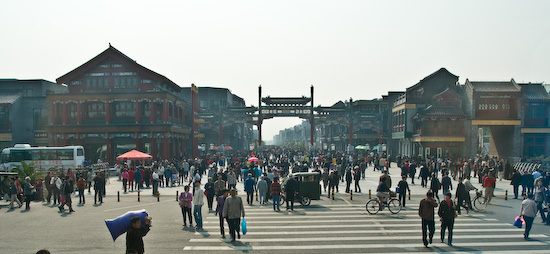
Entrance to Quinamen street as seen from the south Tower of Tianamen.
On top of that Quinamen street is by and large pedestrian only. You can wander at your leisure with little fear of getting crushed by the notorious Beijing driver. Which is not to say you will completely avoid the crush of humanity. Especially at peak tourist times.
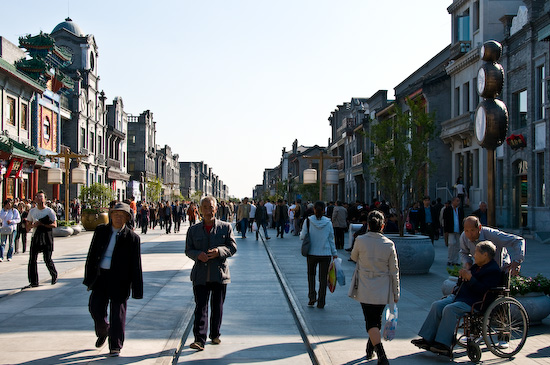
Looking North up Quinamen Street
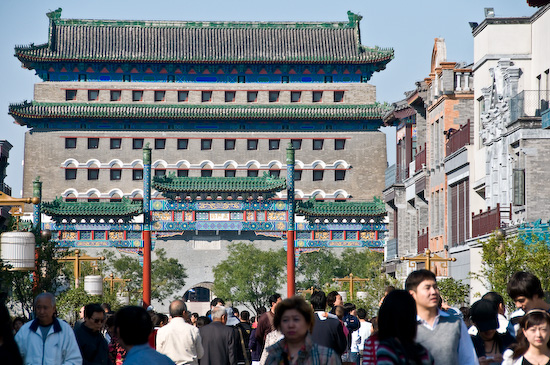
Looking South at the entrance gate and the South Tower of Tiananmen Square.
You can spend your time strolling the avenue or take the Street car when it becomes operational. There are numerous shops of all sorts to visit and a number of excellent restaurants.
As much as Quinamen Street has to offer during the day it take on a whole new life at night. The crowds die down, the lights come on and your treated to a whole different vision of the place.
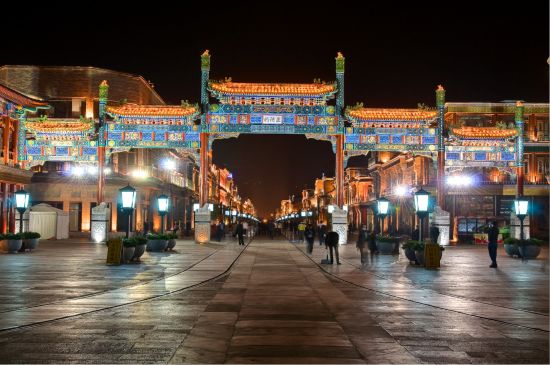
Quinamen Gate at Night – Shot in HDR
While it can be a chore this is definitely when you’ll want to bring a tripod along if you’ve got it. The opportunity for the glowing light show is not to be missed.
This is an excellent occasion to use bracketed exposures. When shooting night shots like this exposure is often an artistic choice. Do you want to emphasize the actual lights themselves or the glow they cast on the buildings around them? Your best bet is a good 5 stop bracket 1 stop apart to give you the maximum flexibility when going over your shots afterwards. It also gives you the added bonus of being able to produce HDR shots like I have here to give it a unique look you don’t get from a single exposure.
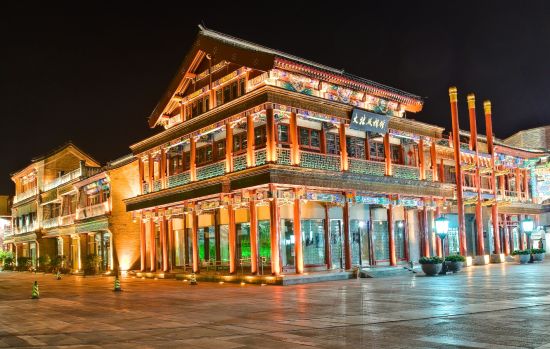
Building to the left of the gate 5 shot HDR.
If there are people in your shot the time exposure (especially with HDR) can give this already exotic scene a ghostly quality.
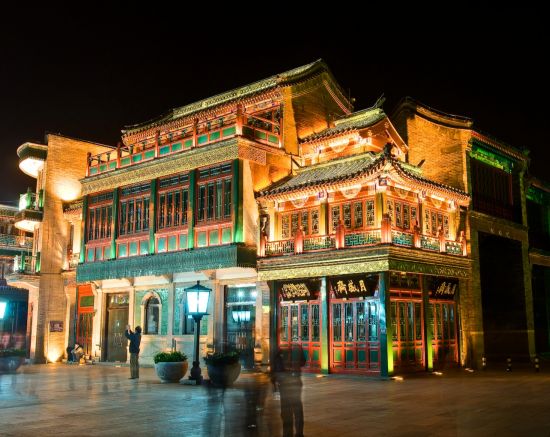
Building to the right of the gate with subject motion. 5 shot HDR.
After you have passed the front gate your treated to a glowing avenue that stretches on into the night.
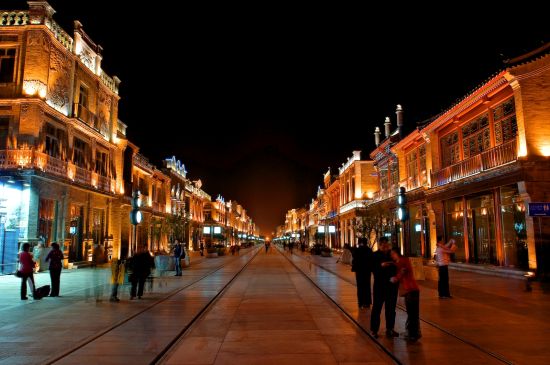
The most scenic bits are to the middle where the have some of the larger and more elaborately lit buildings.
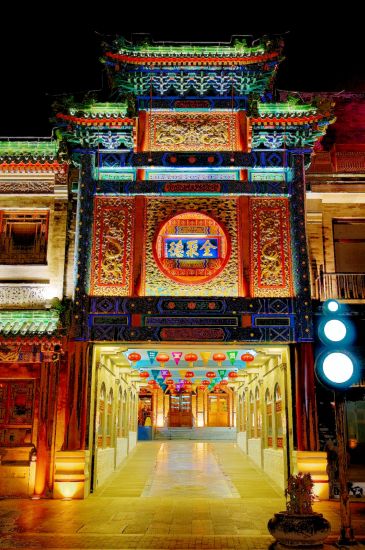
Chinese style lattice work is given a whole new look by tasteful illumination.
Most of the buildings are done in the Chinese style using dept, color and texture to give there best appearance. You’ll see many similarities in the patterns and colors and themes borrowed from the Forbidden City.
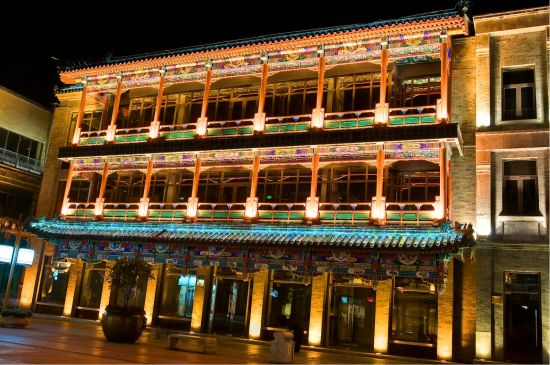
Chinese Styled Period building. 5 Shot HDR.
That’s not to say its all Chinese, there is a hint of turn of the century colonial architecture sprinkled about the street. Most notably the clock tower. Relying on neon traced outlines and broader smoother illumination it gives a different and yet no less attractive look.
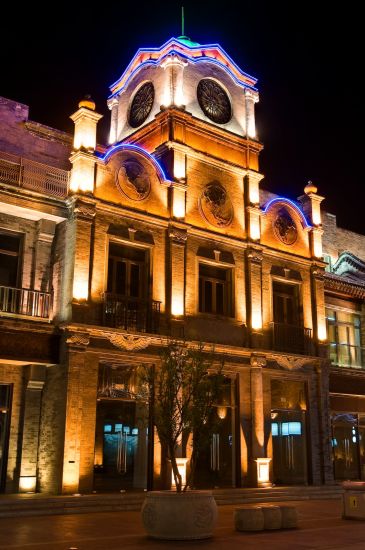
The clock tower is the strongest example of western influence in the architecture. 5 Shot HDR.
That’s not to say its all Chinese, there is a hint of turn of the century colonial architecture sprinkled about the street. Most notably the clock tower. Relying on neon traced outlines and broader smoother illumination it gives a different and yet no less attractive look.
There is a lot more to see and do at Quinamen street and its location to the Forbidden City and Tiananmen square should make it easy to fit in, especially after dark. One thing to consider when scheduling is that the place does officially close at 10pm (they put out barriers to block access). I found that closing time was realistically more like 10:30-10:45. So be sure to get their early enough to give yourself the time your going to want to spend.
Tone Splitting
Because I’m working on a limited workstation/software this week, I’ve selected a fun topic that requires little explanation if your processing software does it for you, but if done manually in Photo Shop can be quite complex. It’s called “tone splitting” and what you’re doing is simply changing the tones/color of certain color channels for a certain effect.
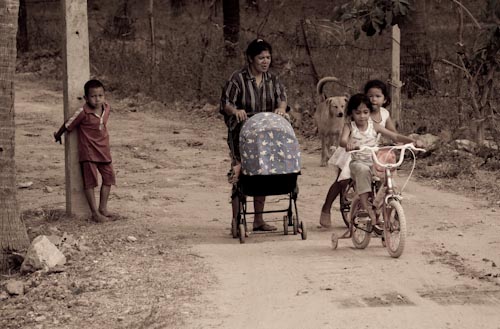
Images from digital cameras are in color. With film you can select black and white or color film/transparencies. Most people don’t realize that black and white emulsions (film) have much more resolution than does color film, and carry tones very well. Color film has roughly 1/3 the resolution of black and white film. Digital images are all in color with the exception of certain Kodak SLRs made 4-6 years ago which were special purpose cameras.
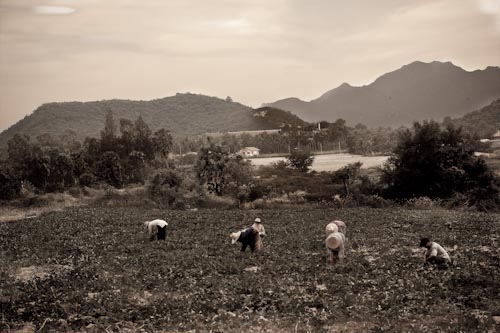
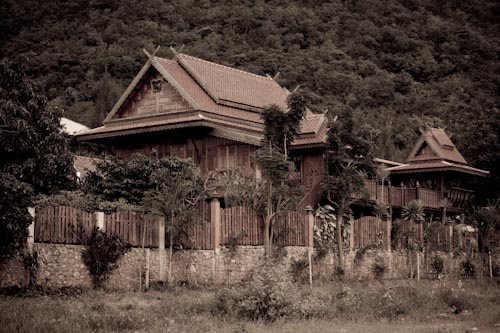
To achieve black and white, sepia, or any of the many “toned” images we manipulate the image data in a process called “tone splitting” which is a simple alteration of the color channels. Unfortunately digital color images and digital black and white images have the same resolution.
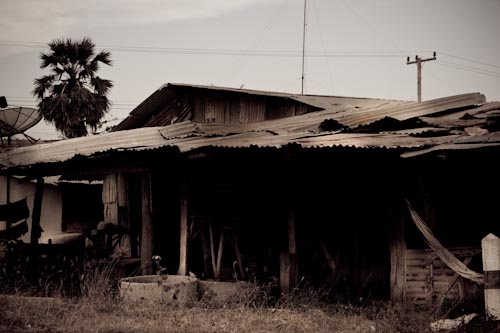
Most image processing software has settings to turn your image to black and white or sepia. Some have many other pre-sets that allow different effects/tones, and some like Lightroom allow you to generate/customize a certain tone and then save those settings as a preset to use at another time.
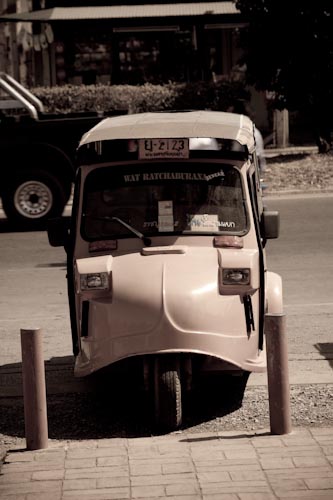
In Photoshop there are two common methods for generating black and white images. You can either take the color slider and de-saturate the colors until all you have left is blacks, whites and grays, or you can use the “gradient” feature which offers far more preservation of tones and contrasts and is the preferred method.
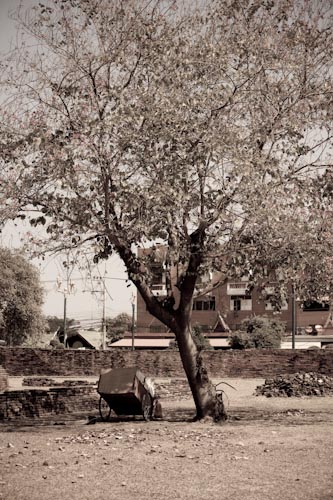
All of the sample photos have been toned to present an “aged” look, a look common with silver emulsion plates used over a 100 years ago. tone splitting images can be a lot of fun and done properly are very popular for weddings (a whitish sepia) and black and white images are still as appealing as ever. Give it a try!
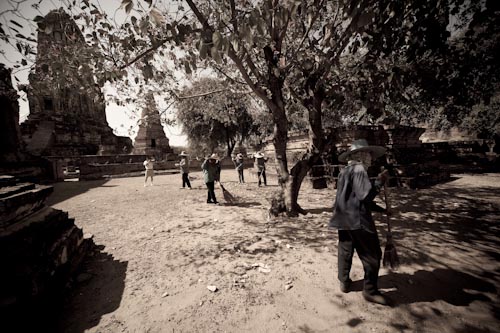
Photography News of Interest
A few weeks ago I mentioned the black dot issue with the new Canon 5d Mark II. Canon has responded in record time with a firmware fix and patched processing software. I can only hope that Adobe’s Camera Raw, Lightroom, Capture One Pro, and other raw processors won’t need to be “patched” to avoid this issue. You can read about and obtain your firmware fix here.
A few years ago I recommended an Olympus point and shoot compact to those who wanted to travel light because of the great zoom range and other features which added up to great value. Well, Olympus has improved on a good thing and made it great with the announcement of the SP-590UZ point and shoot compact with a 26x lens! Yes, that means it’s a 26mm – 676mm (35mm effective) focal length. How’s that for reaching out and touching someone! It’s dual image stabilization should help out at the longer focal lengths. You can read about it here.
Almost 40-50 years ago Polaroid made history with it’s instant developing film that provided the user a print within a minute or two of exposure. A few years ago they discontinued making Polariod film, but not before creating their own genre and loyal following. Today Polaroid announces a digital camera with a built in printer! Will it be has convenient and easy to use as their original product? You can read about it here.
For those of you who didn’t get enough of the US election coverage (is there any of you out there?) some genius is actually going to exhibit photos of the GOP convention. Sigh.. You can read about it here.
Readers Submissions
Hi Steve,
This is a photo I took with my first digital camera, a Ricoh. I cannot remember the model. I remember it was maybe 2 or 3 megapixel, from the window of a Virgin Blue flight. I don’t get into photography like you guys but I appreciate & enjoy a good photo. Although I don’t read all the tech stuff in your column, I enjoy the beautiful photos and sometimes read a little of the high tech. As you state often, the moment and the subject is as critical as the technology. This was Sydney with software autocorrect applied.
Cheers,
Thaigary

ThaiGary –
Great shot! I’m really glad to hear you enjoy the column and are even starting to take onboard some of the technical offerings. Absolutely, being there at the right moment with the right subject is most of the work! I look forward to seeing more images from you.
Steve
Hi Steve,
Here are a few images taken in Laos at the beginning of 2006. The first is of the Patuxai monument in Vientiane (everybody takes this one).

From Luang Prabang I took a two day slow boat ride to Huay Xia, opposite the Thai town of Chiang Khong, with a overnight stay in Pakbeng the halfway stop. The 2nd and 3rd images are of speed boats zooming up and down the Mekong.


the 4th is of a cargo barge,
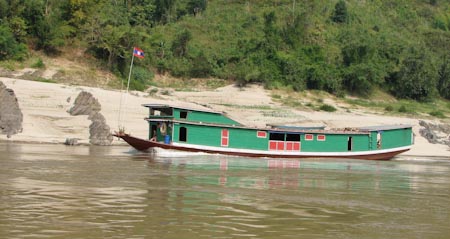
These images were taken from a boat. There was a lot of turbulence when other boats came close. The 5th is of a Lao Indian restaurant in Pakbeng.
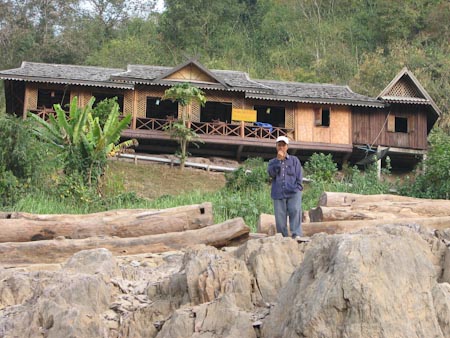
The last is of the main road in Pakbeng. It was very smoky because there was a lot of grilling going on. It was all the same, pig ears, fatty cuts and entrails.
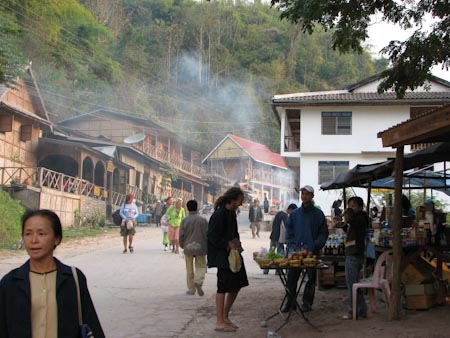
Regards Khunklit.
Khunklit –
Interesting and fun images! You sure have traveled a lot in Thailand. It’s always a pleasure to receive your shots and share them with the viewers. Please keep them coming.
Steve
I suspect the readers submissions will be a highly anticipated section of this column and I encourage anyone with photographs and travel accounts they'd like to share to please send them to me at: QandA@Bkkimages.com
Readers Questions
Hi Steve,
Long time, no email. Hope your photography business is doing well. I believe the last time I emailed you, I was debating whether to buy a Nikon D300 or a Canon 5D. Got the 5D with the 24-105L.
I'm heading to Thailand on vacation next week and will be taking the 5D along. Can't wait! Especially since L.A.'s been unusually cold.
Krabi is on the itinerary and possibly Trang, so I need to get a polarizer for the beach shots. Do I really need a $250 77mm B+W Kaesemann MRC circular polarizer or will a cheap one do? Will image quality be compromised with a crappy one? I've read so many positive comments about the B+W brand and how the Hoyas are also good but are tough to clean. Which do you suggest?
Sukhothai was on my places to go to photograph list, but I'm now leaning towards Ayuttaya after reading your InFocus article and also because of its close proximity to Bangkok. I've been to Ayuttaya before, but only with a p&s camera. So if I wanted to do a tutorial session with you in Ayuttaya, how much do you charge and how much advance notice is required?
One last question, is there any truth to the 50L back-focusing problem?
Thanks,
JP
JP –
Thanks for the questions. Great news on the Canon 5d. I think for your purposes (travel, portraits and landscapes) the Canon 5d is a much better choice than the Nikon D300. The 5d’s full frame sensor will provide much better image quality in all types of light and for your needs the faster handling of the D300 wouldn’t be that much of a benefit.
Let me answer your questions in order:
Polarizer’s: I used to use these religiously with film cameras and lenses 28mm and wider. Now, with digital and digital post processing we can relegate the use of polarizer’s ONLY to the removal of unwanted reflections from water, shiny surfaces, and glass buildings. I carry several in my bag, a Hoya Spro1 which is a standard circular polarizer of very high quality and less than half the price of the B&W you mention. I also carry a Singh-ray blue and gold polarizer which if used effectively can produce some very interesting images.
I find Hoya’s no more difficult to clean than any other brand. And certainly you’ll want a circular polarizer.
Polarizer’s on lenses wider than 28mm will result in incomplete coverage of the entire skyline. This looks terrible so I don’t recommend their use for darkening skies (besides, we can do that better in digital now) but they can still be effective for removing reflections with wider lenses IF the area in the scene is smaller than the frame.
Individual workshops are baht 10,000 per day. We work as many hours in a day as you want, often going 12-14 hours. This might sound expensive on first look, but consider the same level of workshop in the west is at least twice this much and often 3-4 times as much. The cost covers all expenses, the vehicle, insurance, entry fees, and even meals. These last few months not much advance notice is required as tourism along with everything else has decreased, but the more notice the better the chance I’ll be available.
50mm F1.2L backfocusing: With ANY very wide aperture lens you’re going to get a significant number of people (all on photography forums it seems) complaining of focusing issues. 99/100 the real problem is the person doesn’t have the experience to properly use this type of specialized lens at its maximum aperture. The 50mm F1.2 like the 85/1.2 and 135/2, require special techniques when used wide open and are very rewarding to use.. but only under special conditions.
JP, I hope I’ve answered all your questions and even more during the workshop we enjoyed together. I hope you’re having a great time in Krabi and Trang and that you take some great images and share them with our readers. If you’re back in Bangkok before your flight feel free to give me a call and stop by to use the computer to view and process your images. I’ll be happy to answer any further questions that come up about Lightroom or postprocessing.
Great shooting!
Steve
Please submit your questions to QandA@Bkkimages.com All questions will be answered and most will show up in the weekly column.
A Snapshot of Bangkok Images Week in Review
This week was eventful. I had a great time with a individual workshop with an experienced photographer as we discussed landscape techniques and composition, and then returned and spent a lot of time learning Lightroom. We left from his hotel at 0930 and it was 2330 when we wrapped things up and called it a day. The time went by so fast we didn’t even notice the late hour until we started yawning!
When I wasn’t preparing images for client orders or out with the workshop I was experiencing great frustration trying to keep Bangkok Images’ computers up and running. I’ll have several great pieces of information to share with you about warranty service in Thailand by the time we get everything back up. Read about some of these experiences in the InFocus Blog below..
Infocus Blog
Murphy’s Law: Everything that can go wrong, will go wrong.
There aren’t many things in the world you can believe in 100% of the time, but you can take Murphy’s Law to the bank!
While the rest of the world was enjoying the winter holidays yours truly was fighting for survival and trying to keep his head above water as the electronic gremlins created havoc with my imaging workstations and networks. Over the course of the last two weeks I’ve lost over 15 pieces of computer equipment on three separate days!
It started with all three of my 21.5” LCD image monitors going bad. After 5-6 years of service I figured they were due and promptly took them to a local repair center where they’re still being serviced. Parts should be in soon and hopefully I’ll have my monitors back.
Several days later my main imaging workstation stopped working. This is a special water cooled high powered graphics workstation that I designed and built just to bring to Thailand and use in the heat. With a quad core processor, two high-end video cards, and 8tb’s of storage I learned to depend heavily on this workstation. Using it has been a pleasure and for three years I didn’t have a lick of trouble.
When it stopped working I placed it on the operating table and opened up the clean and shiny tower case. Inside I found enough accumulated dirt and grit to start a small garden.

By the time I disassembled everything my hands and clothes were so dirty it felt like I’d been working on an old car. It took two days of careful cleaning to restore everything to it’s original state.

Above you can see that my server class 1000 watt power supply was more than a little dirty inside. The fan sucked in air and the dirt in the air and filled up every crack and space inside.

In the picture above you can see about a ½” of dirt covering the regulator circuit board!

In this picture above you can see why the power supply went bad bringing down the entire system! Even though I regularly cleaned the outside vents and filters I never took the PS from the case to clean the input vent. It was almost completely blocked impeding the air floor. Heat is the number one enemy of electronics. Power surges is number two.

Here are the 12 SATA II hard drives that make up my RAID array and system storage. Fortunately they’re fine as is all the data they contain.

This is the operating table with all the internal organs removed. Two days after disassembly everything was cleaned up and reinstalled. Air cooling systems have greatly improved over the last 2-3 years so I removed the water cooling radiator, water pump, holding tank, and anti-freeze and installed a super air cooling tower in its place. I’m currently awaiting the replacement power supply (under warranty) which I hope to have this week. Once it’s back together I’ll snap a few more pictures to share next week.
You’d think that would be my share of electronic problems for quite some time. Unfortunately 4 days after the workstation went down I woke up smelling burned insulation and discovered that my office was full of smoke. I had a 1500ma server class Uninterruptable Power Supply (UPS) powering my secondary workstation, color laser printer, image printers, network storage drives, routers, modems, gigaswitches, and all my battery chargers and other photography chargers. The UPS had failed in a big way taking every AC/DC transformer plugged into it with it.
I spent the next two days hunting down new transformers and installing a brand new UPS to get my intralan network back up and operating. I’ve still a few transformers to hunt down, but I’m mostly up and operating.
This weeks column was produced on one of my laptops which while fine for light duty use, are not even close to being as nice and powerful as my workstation. Hopefully I’ll have my workstation back on line before I start on next weeks column, which will give me access to my image archives.
What can go wrong, will go wrong. With this in mind I’ve avoided my car and major appliances and I’ve made it a point to take the stairs down the 16+ floors lest the lift decide to be controlled by the gremlins. Speaking of lifts the following is a true story.
My son and I had just exited one of the four lifts in my building. We were almost inside the apartment when we heard a very loud screeching metal on metal noise getting louder and louder and then passing our floor. Suddenly this 32 story building shook and a very loud BANG was heard. The building settled down and stopped shaking as my son and I looked at each other in alarm.
The next day we noticed one of the lifts was out of order and it stayed out of order for over three months. One day it was working and inside was a brand new lift car! Considering the recent fire at the Santika club and Thailand’s notorious lack of safety regulations/inspections I’ve started rethinking the stairs.
A neighbor recommended I rent a gaggle of monks to come to my place and bless everything and perhaps that’s not a bad idea. I wonder how many monks will squeeze into one lift?
Until next time..



